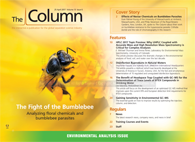Studying the Effects of OCPs on Human Health Using SPE and GC–ECD
Researchers from the Universidad Autónoma de Yucatán in Mexico, have used solid-phase extraction (SPE) and gas chromatography–electron capture detection (GC–ECD) to study the effects of organopesticides in the Yucatán region of Mexico.
Photo Credit: Pierdelune/Shutterstock.com

Researchers from the Universidad Autónoma de Yucatán in Mexico, have used solid-phase extraction (SPE) and gas chromatography–electron capture detection (GC–ECD) to study the effects of organopesticides in the Yucatán region of Mexico (1,2).
In rural Mexican communities, the use of organochlorine pesticides (OCPs) to protect crops is a common practice. Women produce vegetables and fruits in their backyards as well as raise pigs and poultry for self-consumption, using OCPs in the process. Poverty is widespread in these communities, along with low levels of education, and a general lack of knowledge in the use of toxic agrochemicals. This lack of understanding combined with the well-known propensity off OCPs for environmental persistence, bioaccumulation, and adverse effects on humans and the environment, has led to unusually high levels of cancer within these communities.
One such region with this problem is the Yucatán region of Mexico, an agriculturally heavy region, where an estimated 30% of the population regularly drink water polluted with OCPs.
“A lot people do not have access to clean drinking water in the rural zones,” explained Angel G. Polanco Rodriguez, lead author of the study. “They are drinking polluted water normally from the wells, lakes, and sinkholes.”
This regular exposure to OCPs has observable consequences with the Yucatán region having the highest overall mortality rate in Mexico from cervical cancer over the period of 1990–2010 (3).
“Uterine and breast cancer cases are high in developing countries. Cancer is a multifactorial problem in which the environmental factors play an important role, but it is important to note that these pesticides are endocrine disruptors which affect the hormonal system and can produce diverse cancers,” said Rodriguez.
Further to the oncological issues causes by pesticides, neurodevelopmental disorders are also common in children because the OCPs are also potent neurotoxic agents.
“Years ago the organochlorine pesticides were banned by the international community at the Stockholm Convention,” explained Rodriguez. “All countries have norms to control the permitted limits of concentrations in water, soil, etc. However, in developing countries these norms and laws are not fulfilled.”
To understand how OCP exposure affects these communities, researchers from the Universidad Autónoma de Yucatán have collected data from two sets of women from the region. The first study collected blood samples from women suffering from uterine cervix cancer, analyzing their blood using SPE cartridges and GC–ECD (1). The second study monitored the levels of organic pollutants in the breast milk of Maya women from the Yucatán region using both SPE cartridges and GC–ECD once again (2).
Evidence for the bioaccumulation of OCPs in the blood of Maya women was found, with the study also identifying several factors that could be contributing to the bioaccumulation. The karstic soil of the Maya area was particularly highlighted because it filtered the OCP into the groundwater. Deforestation and the sinkholes, faults, and fractures associated with karstic soil along with social conditions were found to cause chronic exposure as the local populous utilized the polluted water sources of the area.
Similar results were identified in the breast milk of Yucatán residents with significant amounts of OCPs being identified. These OCP residues are likely to predispose women to breast cancer and their children to neurodevelopmental disorders.
Both studies were exploratory in nature with researchers currently carrying out further research into the topic. - L.B.References
- Á.G.P. Rodríguez et al., Environ. Pollu.220, 853–862 (2017).
- Á.G.P. Rodríguez et al., Environ. Monit. Assess.189, 59 (2017).
- SSY, 2011. Servicios de Salud de Yucatan. 5 Curso internacional de prevencion control de cancer cervicouterino. BOLETIN_SSY_061. www.oecd.org/health/

New Method Explored for the Detection of CECs in Crops Irrigated with Contaminated Water
April 30th 2025This new study presents a validated QuEChERS–LC-MS/MS method for detecting eight persistent, mobile, and toxic substances in escarole, tomatoes, and tomato leaves irrigated with contaminated water.

.png&w=3840&q=75)

.png&w=3840&q=75)



.png&w=3840&q=75)



.png&w=3840&q=75)










